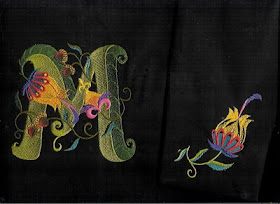I really hate to admit it when something (knitting-wise) seems to be defeating me. I'm referring to Diana's Zig Zag Scarf.
http://diananatters.blogspot.com/2010/03/new-video-today-zigzag-racked-ribber.html
I was determined to make it. Wrote down the instructions while watching her video, made my own spread sheet---just like hers. The pattern, or something, didn't like my machine and my machine didn't like the pattern. At first I thought it was static, then I zigged when I was supposed to zag (see picture), then I thought my machine needed oiling and I tried about 12 different yarns and tensions. The picture below is actually the best of my disasters.

The question mark indicates "What was I thinking?" The result is interesting, but not interesting
enough to keep, if you know what I mean. Hmmm...maybe in the future I could go twice as many rows in one direction. But a person really should get the original pattern correct before going off on a tangent. Had a friend check out my directions to see if I was doing it right. I thought that this shouldn't be so hard. I felt like I was having a heart attack trying to move the carriage back and forth. I knew there would be no way I could do 600+ rows. And, Diana didn't seem to be having any trouble pushing the carriage in her demo. Not having any joy with anything I tried, I knit a few other things in the interim to check to make sure my machine really was ok.
Finally, I broke down and wrote to Diana and asked if she had any suggestions. I was kind of embarrassed because it's not exactly like I'm a novice knitter. She was most gracious and even said she loved a puzzle! She confirmed that I was racking in the correct sequence, so that was the main thing. I was apologetic about wasting her time, but she was non-plussed about it. What a sweet person!!! She's as nice as she sounds in her videos.
Yesterday then, after getting confirmation from the expert that it
should be working, I thought I would try ONE MORE YARN. Finally, it worked. It's a beautiful pattern. Then the phone rang, I ran to answer it, came back, checked my cheat sheet and off I went again only to find out A FOOT LATER that I zagged when I was supposed to zig. O well, I found a yarn and a tension that my machine would cooperate with. This is my "good" swatch. (Not showing you my wrong turn...)

For now, this was enough.
Don't let my experience discourage you. You probably will fly right through it.
The question for me remains, will I have the concentration to stick with it again and not make any mistakes for 6 long feet? There really is NO room for error. It's frustrating to not be able to see what you're doing until way past the point where an error may have occurred. And, there's no way I could rip back and find the right spot in the pattern. I have a knitting friend who probably could, (hi Ellen), but not me. This is one of those all or nothing deals. Do I get to count on my knit meter the 1,000 yards of yarn I used trying to get this right???? (I guess not.) And, finally, what the heck was I doing wrong on the previous 12 or so swatches? I'm suspecting tension, but don't know for absolute sure. I guess it will have to remain a mystery.

 The mottled items are the gray mixed with another mystery egg shell colored yarn. Another giant cone I got I know not where. I didn't twist them like a person probably should, just ran them up through separate yarn feeders. Kind of cool I think, the randomness. Good feeling to use up yarn, but there are so many cones to go! My goal is to have just enough yarn to fill one yarn tree and no more. Have a lot of plastic bins to attend to still. Stay tuned!
The mottled items are the gray mixed with another mystery egg shell colored yarn. Another giant cone I got I know not where. I didn't twist them like a person probably should, just ran them up through separate yarn feeders. Kind of cool I think, the randomness. Good feeling to use up yarn, but there are so many cones to go! My goal is to have just enough yarn to fill one yarn tree and no more. Have a lot of plastic bins to attend to still. Stay tuned!















